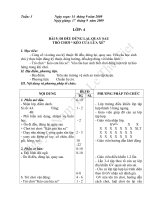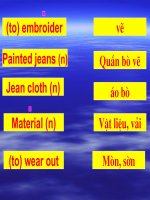- Trang chủ >>
- Mầm non - Tiểu học >>
- Lớp 5
5 5 5 the gold rush of 1849
Bạn đang xem bản rút gọn của tài liệu. Xem và tải ngay bản đầy đủ của tài liệu tại đây (7.88 MB, 14 trang )
Suggested levels for Guided Reading, DRA,™
Lexile,® and Reading Recovery™ are provided
in the Pearson Scott Foresman Leveling Guide.
The
Gold Rush
of 1849
by Peggy Bresnick Kendler
Genre
Expository
nonfiction
Comprehension
Skills and Strategy
• Generalize
• Main Idea and
Details
• Graphic Organizers
Text Features
• Table of Contents
• Captions
• Maps
Scott Foresman Reading Street 5.5.5
ISBN 0-328-13574-7
ì<(sk$m)=bdfhef< +^-Ä-U-Ä-U
Vocabulary
economic
Reader Response
The
Gold Rush
of 1849
freight
1. People came to the American River to find gold and
become rich. Were most people successful? Why or
why not?
independence
2. In a graphic organizer like this one, list facts about
California before and then after the Gold Rush.
overrun
recalled
California Before
the Gold Rush
California After
the Gold Rush
scrawled
vacant
ventured
Word count: 1,192
3. The words independence and recalled both have
prefixes. Write the prefix of each word. Then tell how
the prefix changes the base word’s meaning. Use each
word in a sentence.
4. If you were
in 1849,
would Kendler
you have traveled to
byalive
Peggy
Bresnick
California to make your fortune? Explain your answer.
Note: The total word count includes words in the running text and headings only.
Numerals and words in chapter titles, captions, labels, diagrams, charts, graphs,
sidebars, and extra features are not included.
Editorial Offices: Glenview, Illinois • Parsippany, New Jersey • New York, New York
Sales Offices: Needham, Massachusetts • Duluth, Georgia • Glenview, Illinois
Coppell, Texas • Ontario, California • Mesa, Arizona
CONTENTS
CHAPTER 1
4
CHAPTER 2
6
CHAPTER 3
12
CHAPTER 4
19
CHAPTER 5
20
The Gold Rush
They Found Gold!
The Long Journey West
Failure and Frustration
Every effort has been made to secure permission and provide appropriate credit for
photographic material. The publisher deeply regrets any omission and pledges to
correct errors called to its attention in subsequent editions.
After the Gold Rush
Unless otherwise acknowledged, all photographs are the property of Scott Foresman,
a division of Pearson Education.
Photo locators denoted as follows: Top (T), Center (C), Bottom (B), Left (L), Right (R),
Background (Bkgd)
Opener ©Bettmann/Corbis; 1 ©Minnesota Historical Society/Corbis; 4 ©Bettmann/
Corbis; 6 (Inset)©Bettmann/Corbis, 6 (Bkgd) ©Bettmann/Corbis; 8 ©Bettmann/
Corbis; 10 (Inset)©Minnesota Historical Society/Corbis,10 (Bkgd)©Bettmann/Corbis;
12 ©Hulton Archive/Getty Images; 13 North Wind Picture Archives; 14 North Wind
Picture Archives; 16 (Bkgd)©Lowell Georgia/Corbis; 17 (Bkgd)©Bettmann/Corbis;
18 Corbis; 20 (Bkgd)©Galen Rowell/Corbis; 21 (Inset)©Hulton Archive/Getty Images;
22 ©Leonard de Selva/Corbis
ISBN: 0-328-13574-7
Copyright © Pearson Education, Inc.
All Rights Reserved. Printed in China. This publication is protected by Copyright,
and permission should be obtained from the publisher prior to any prohibited
reproduction, storage in a retrieval system, or transmission in any form by any
means, electronic, mechanical, photocopying, recording, or likewise. For information
regarding permission(s), write to: Permissions Department, Scott Foresman, 1900 East
Lake Avenue, Glenview, Illinois 60025.
4 5 6 7 8 9 10 V0H3 14 13 12 11 10 09 08 07 06
3
Chapter 1
The Gold Rush
The race for gold changed America’s history
and its landscape. During this time, many people
traveled to the California area. These pioneers
dreamed of finding gold and becoming rich.
People traveled to the
American River to find gold.
The California Gold
Rush started in 1849.
California was controlled by Mexico in the
early 1840s. In 1848, Mexico gave up its claim.
The area now had its independence from Mexico,
but it was not yet a state. More and more people
ventured west to California. Some made the
journey by boat and others by land.
4
5
Sutter built a huge complex. His head office
was in the three-story Central Building. It was
surrounded by the other buildings in the complex.
Chapter 2
They Found Gold!
John Sutter was one
of the richest people
in California in the
1840s. Sutter came from
Germany in 1839 to make
his fortune. He dreamed of
building a large farming empire.
The Mexican government gave a land grant to
Sutter. In return, Sutter had to keep order among
the people and keep the land safe for Mexico.
Sutter began to build his farming empire on 48,827
acres of land near the Sierra Nevada. He soon had
more than 12,000 cattle and sheep on his farm.
6
Gold was first found on John Sutter’s land in 1848.
7
In 1840, Sutter built a huge fort on the
Sacramento River. It had sleeping quarters for
some of his workers. It also had a bakery, a blanket
factory, a blacksmith shop, a carpenter shop, and
other workshops.
Six years later, Sutter hired James Marshall to
build a sawmill on the American River. On January
24, 1848, Marshall saw something shiny in the water.
He picked up the piece of sparkling metal. It was
half the size of a pea. He had found gold!
Marshall and his workers
found more bits of gold near the
sawmill. Sutter was worried about
it. He wanted to keep building
his farming empire for economic
gain. He didn’t want a lot of
people coming to his land to look
for gold.
Sutter and Marshall wanted to
keep the gold a secret. They were
not successful. A merchant named
Sam Brannan spread the word
and the Gold Rush began.
James Marshall found gold in
the water near Sutter’s Mill.
8
9
Sam Brannan was a San Francisco
merchant. He had a plan to spread the
word about the gold discovery and
make himself rich. First, he bought
every shovel, pan, and pickaxe he could
find. Then he ran through the streets
with a small pot of gold dust screaming
about the gold. He sold his gold mining
tools for a lot of money. Before gold
was discovered, a metal pan cost just
twenty cents. He sold the
same type of pan for $15.
Brannan made more than
$36,000 in just nine weeks.
10
The area was soon overrun by people looking
for gold. Sutter could not keep his land from being
crowded with so many people. By the end of 1849,
Sutter’s farming empire was ruined. The people
seeking gold destroyed his fort and crops.
Sam Brannan spread the word and
started the Gold Rush.
11
Chapter 3
The Long Journey West
Soon after gold was discovered,
prospectors rushed to California. They
would be gone from their families
and homes for a long time. Still, they
thought it would be worth the difficult
trip. They thought their lives would be
much better if they could come home
with enough gold to make them rich.
People from the East had only
two ways to get to California: the
Oregon-California trail or an ocean
voyage. Either way, the trip was very
long. To get to the West Coast, people
drove wagons, rode horses, or traveled
by ship.
Gold seekers suffered a long, hard journey to the West.
12
13
Many people from the East chose to travel
by ship to California. The route around the
southern part of South America could take
more than six months.
The trip was miserable. Many travelers got
seasick. Their food became rotten and full of
bugs, and there was little fresh drinking water.
Once they reached California, many had to wait
to be taken to the American River. Some waited
many months in small coastal towns. These towns
were overcrowded and many people became ill.
By sea
Overland
14
15
People from the Midwest most often traveled
to California by land. They went by foot, wagon, or
horse and had to watch out for bandits. So many
wagons used the Oregon-California trail that the
wheels wore deep ruts in places.
In 1848, there were about 5,000 miners in
California looking for gold. In 1849, there were tens
of thousands of miners. Unfortunately, most miners
found very little gold or none at all.
Although many people gave up and left
California, thousands stayed. They were upset that
they had traveled so far and had nothing to show
for it. Many of the men were homesick when they
recalled the life they had before they came west.
Many miners gave up their dream of
striking it rich and went back home.
16
17
Chapter 4
Failure and Frustration
At first, gold was easy to find in the waters of
the American River. Many of the first people to
reach the gold fields became rich. However, not
all of the miners were as lucky. In time, there was
very little gold left.
People who managed to find gold didn’t
find enough to make them rich. They had to use
their gold to pay for food and shelter. The men
who made the most money were those who sold
supplies and services to the miners.
We are lucky to know a lot about the lives of
these miners. Many of them scrawled notes in
diaries and sent letters home to their families.
18
19
Chapter 5
After the Gold Rush
During and after the Gold Rush, California
changed greatly. In the early 1840s, there were
only 5,000 people living in California. By the
time James Marshall found the first pieces of
gold, there were 14,000 people in California. By
the end of 1849, the number of people rose to
nearly 100,000. Just three years later, there were
250,000 people living in California.
In 1850, just one year after the Gold Rush
began, California became the 31st state of the
Union. Part of the reason was the area’s fast
growth.
After the Gold Rush ended, the small towns
where many miners had lived were vacant. These
towns are called ghost towns. Some of these
towns were preserved, so we can now see how
people lived during the Gold Rush.
John Sutter went through tough times during
and after the Gold Rush. His great plans for
building a farming empire were ruined by goldseekers. Some of the miners used his fort as a
trading post for their supplies. Crooks swindled
Sutter out of his land. At the end of 1849, he
sold his fort for only $7,000.
20
Sutter lived at Hock Farm with his family until
a former employee burned down his house. He
went to Washington, D.C., and tried to
get paid for his help in bringing
people to California and
making it a state. He did
not get any money from
the government. He died
in Pennsylvania in 1880.
After the Gold Rush, John Sutter lived
for a while at Hock Farm.
21
The people who stayed in
California after the Gold Rush
needed to earn a living. They
became farmers, merchants, and
ranchers.
California was not the only
place in the west where gold was
discovered. There were other gold
rushes in Alaska, Arizona, Idaho,
Montana, Nevada, New Mexico,
South Dakota, Utah, and Wyoming.
The discovery of gold in the
American River was one of history’s
greatest events. The Gold Rush
of 1849 became one of America’s
greatest adventure stories.
22
23
Glossary
Vocabulary
economic
economic
adj. related
to money, business, and
trade
freight
independence n.
condition
of being free
independence
from the control of others
overrun
overrun
v. to spread
through quickly
Reader Response
recalled v. remembered
scrawled v. wrote quickly
and sloppily
vacant adj. empty
ventured v. did something
risky, often used in terms
of travel
recalled
1. People came to the American River to find gold and
become rich. Were most people successful? Why or
why not?
2. In a graphic organizer like this one, list facts about
California before and then after the Gold Rush.
California Before
the Gold Rush
California After
the Gold Rush
scrawled
vacant
ventured
Word count: 1,192
3. The words independence and recalled both have
prefixes. Write the prefix of each word. Then tell how
the prefix changes the base word’s meaning. Use each
word in a sentence.
4. If you were alive in 1849, would you have traveled to
California to make your fortune? Explain your answer.
Note: The total word count includes words in the running text and headings only.
Numerals and words in chapter titles, captions, labels, diagrams, charts, graphs,
sidebars, and extra features are not included.
24









